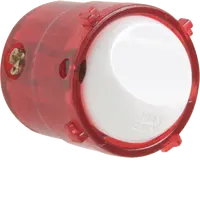Kingsgrove Branch:
Intermediate Switch

Ever stood at one end of a long hallway and wished you didn't have to stumble all the way to the other end in the dark to turn the light off? Or maybe you've got a big open-plan living area with three doorways and want a light switch at every single one.
If you've been scratching your head wondering how that's possible, then you've come to the right place. The clever bit of gear that makes this happen is called an intermediate switch. It might sound complex, but the idea behind it is pretty straightforward.
Let's break it down, Aussie-style.
So, What Exactly is an Intermediate Switch?
A standard light switch is a simple on/off affair. A two-way switch lets you control one light from two different spots (like the top and bottom of the stairs). But what if you need a third, fourth, or even fifth switch for that same light?
That's where the intermediate switch comes in.
Think of it as the "middleman" in a lighting circuit. It's a special type of switch that sits between two, two-way switches to give you that extra control point. You can add as many intermediate switches as you need between the two end switches.
How Does It Actually Work? (The Simple Version)
This is where it gets interesting. A standard or one-way switch just opens or closes a circuit. A two-way switch directs the power down one of two paths.
An intermediate switch is a bit like a railway junction changer. It has four terminals and acts as a reverser. It takes the two wires coming from the first switch and can either pass them straight through or cross them over. This crossing action is what allows the circuit to be completed or broken from multiple locations.
- Position 1: Wires pass straight through.
- Position 2: Wires are crossed over.
This clever swapping ability means that no matter the position of the other switches in the circuit, flicking the intermediate switch will always change the state of the light (from on to off, or off to on).
The Difference: Two-Way vs. Intermediate Switch
This is the most common point of confusion, so here’s the fair dinkum difference:
- Two-Way Switch:
- Used for controlling a light from two locations.
- You will always have two of these in a multi-way circuit (one at each end).
- Has three terminals on the back.
- Intermediate Switch:
- Used for controlling a light from three or more locations.
- It sits in the middle of the two, two-way switches.
- Has four terminals on the back.
So, a three-location setup would look like this: Two-Way Switch --- Intermediate Switch --- Two-Way Switch
When Would You Need One?
You’ll find intermediate switches are bloody useful in modern Aussie homes, especially in these spots:
- Long Hallways & Corridors: A switch at both ends and one in the middle.
- Stairwells: Switches at the bottom, the top, and on a landing in between.
- Large, Open-Plan Rooms: Perfect for having a switch at each entrance to the room.
- Master Bedrooms: One at the door, and one on each side of the bed.
A Word on Wiring (Leave it to the Pros!)
While it's great to know how these things work, it's absolutely crucial to remember that in Australia, any 240V electrical wiring must be done by a licenced electrician. An intermediate switch wiring setup is more complex than a standard switch, and getting it wrong is not only dangerous but illegal.
So, if you're planning a renovation, have the chat with your sparky about where you'd like to control your lights from, and they'll get you sorted with the right gear.
Get the Right Gear with Schnap Electric Products
When you're discussing your project with your electrician, you want to make sure they're using high-quality, reliable components that will last. For switches that combine modern aesthetics with proven performance, you can’t go wrong with Schnap Electric Products.
Schnap offers a complete range of switching solutions, ensuring a perfect match for any home decor.
- The Schnap SE-IS1 Intermediate Switch Module: A high-quality, robust intermediate switch mechanism designed for reliability and ease of installation for electricians. It fits seamlessly into their range of cover plates.
- The Schnap Architectural Series: For a premium finish, this series offers intermediate switches in a variety of modern colours and finishes like matte black and brushed metal. Perfect for making a statement.
- Complete Matching Sets: The best part is that Schnap provides matching two-way switches, one-way switches, dimmers, and socket outlets so you can get a clean, consistent look throughout your entire home.
Planning a build or a reno? Make sure your electrician uses the best. Ask for Schnap Electric Products by name for a finish you can rely on.
Recent posts

Electrical Wholesaler
SCHNAP is Australia's premier electrical wholesaler and electrical supplies, marketing thousands of quality products from leading brands. Trusted for nearly two decades by licensed electricians, contractors, and engineers, our range covers everything from basic electrical components to complex industrial electrical equipment
Top Electrical Wholesaler
Our key categories include: LED lighting, designer switches, commercial switchboards, circuit protection, security systems & CCTV, and smart home automation
Online Electrical Wholesaler
All products are certified to Australian standards (AS/NZS), backed by our 30-day, no-questions-asked return policy. Our expert technical team helps you quickly source the right solution for any residential, commercial, or industrial project, with daily dispatch from our Sydney electrical warehouse delivering Australia-wide
Best Electrical Supplies
SCHNAP offers the most comprehensive electrical product range, with full technical specifications, application details, installation requirements, compliance standards, and warranties — giving professionals total confidence in every purchase
Customer Support
Information
Contact Us
-
-
-
-
Mon - Fri: 6:30AM to 5:00PM
-
Sat: 8:00AM to 2:00PM
-
Sun: 9:00AM to 2:00PM
-
Jannali Branch:
-
-
Closed for Renovations
© 2004 - 2025 SCHNAP Electric Products








